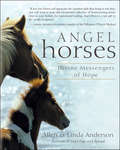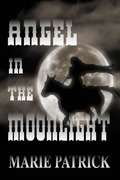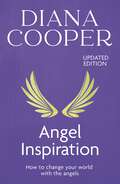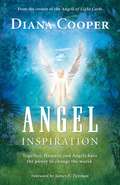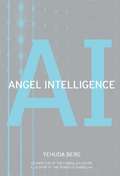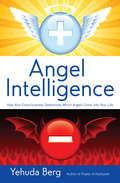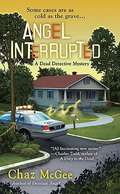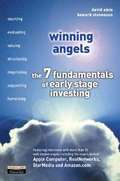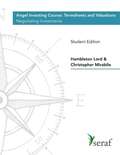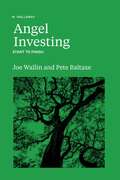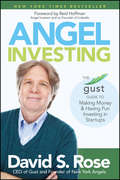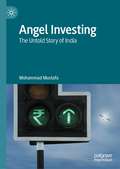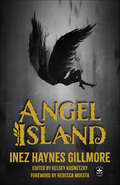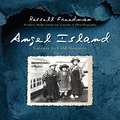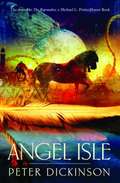- Table View
- List View
Angel Horses
by Linda Anderson Allen AndersonThis inspiring collection of stories tells of the hope and healing that come from contact between horses and people. Whether giving disabled riders a sense of freedom and mobility, healing wounds of childhood abuse, assisting with work, or simply riding trails with their human companions, horses bond with people in ways that change us for the better. The stories, contributed by people from all over the country and from all walks of life, introduce: Cholla, the horse who paints pictures; a veterinarian who was reminded of the importance of compassion by a dying horse and a Native American chief; Star, a horse who saved a teenage girl from suicide; the late-blooming rider who embarrassed a horse and learned an important lesson about respecting the feelings of others -- even if they have four legs; and many others. Every horse lover knows that horses, whether running through fields or performing intricate dressage drills, carry not only their riders but also messages of unconditional love and hope.
Angel Hug
by Shelley J. AlongiThe Author describes how Jesus endured the night at Gethsemane before the Crucifixion in her own version of the well-known story.
Angel In Chains
by Cynthia EdenMortal SinAs a fallen Angel of Death, Azrael is cursed to walk the earth alone in search of redemption. One night, as he wanders the streets of New Orleans, he discovers a woman surrounded by panther shifters. No longer able to contain the anger simmering within, Az summons his dark powers and attacks, determined to protect this innocent human from certain death. Only Jade Pierce is no delicate flower. She's spent years learning to survive and fight the evil forces sent by her ex-lover who refuses to let her go. But after seeing Az in action, she figures she could use a little supernatural help. And so she plans a course of seduction guaranteed to arouse his interest and his angelic passions. . .
Angel In The Forest
by Mukanyandwi BéatriceThis book for early readers tells the story of a blind girl who was bored and alone at home and decided to go meet with her mom who had gone to the market.
Angel In The Moonlight
by Marie PatrickCallie Maxwell wants nothing more than to find the men responsible for the violence committed against her family and bring them to justice. She isn't about to let Austin Kincaide, the by-the-book U.S. Marshal sent to solve the murders, stop her. Nor can she stop herself from falling in love with him even as she defies his orders not to interfere with his investigation. As the Angel of Justice, Callie's alter-ego, she rides in the moonlight, daring the killers to try again. Haunted by the memory of the woman he lost not once, but twice - first to the love of another man then to a tragic mistake which led to her death - Austin is a man shackled by the self-imposed rules he uses to protect his fragile heart. Is Callie the woman with enough love in her heart to shatter Austin's rules and let him love again?
Angel In the Middle
by Marie DeesThe battle between Heaven and Hell rages on. And now Darius, the most naïve angel ever to fall from grace, is caught in the middle. Reduced to seeking advice from angel turned demon, Tribal, Darius' only hope is to seduce the demon hunter searching for him. But just how is he supposed to accomplish this when he doesn't know the first thing about sex and seduction?When Darius, the most naïve angel ever bounced out of Heaven, falls from grace and lands in Ybor City, Florida, he finds himself caught in a power play between Heaven and Hell. In desperation, he realizes he must follow the advice of Tribal, a fallen angel turned demon. Tribal advises Darius to seduce the demon hunter coming after him as a way to avoid going to Hell. But how can an angel, who has never experienced sex, seduce Franco, the big bad demon hunter, and just what does Tribal stand to gain by playing Cupid?Content Notes: gay sex, including a threesome
Angel Inspiration: Together, Humans And Angels Have The Power To Change The World
by Diana CooperHealer and spiritualist Diana Cooper offers her wisdom on how, together, humans and angels have the power to change the world. We are only now opening up to the presence of angels and their ability to guide us. Diana Cooper introduces us to the importance of them in our lives by drawing on countless stories of people who have had their own lives changed by the miraculous assistance of angels. These incredible accounts prove what a difference the divine messengers can make and are an inspiration to us all. Everyone has their own guardian angel, there to help and protect whenever possible. Few of us yet understand, however, the healing and support these angels can bring us and how to invoke their help. Diana Cooper introduces us to the whole hierarchy of angels and the special powers that we can call upon. With exercises and lessons to encourage your angelic presences, Angel Inspiration not only brings you closer to your angel but helps change other people's lives too.
Angel Inspiration: Together, Humans And Angels Have The Power To Change The World
by Diana CooperHealer and spiritualist Diana Cooper offers her wisdom on how, together, humans and angels have the power to change the world. We are only now opening up to the presence of angels and their ability to guide us. Diana Cooper introduces us to the importance of them in our lives by drawing on countless stories of people who have had their own lives changed by the miraculous assistance of angels. These incredible accounts prove what a difference the divine messengers can make and are an inspiration to us all. Everyone has their own guardian angel, there to help and protect whenever possible. Few of us yet understand, however, the healing and support these angels can bring us and how to invoke their help. Diana Cooper introduces us to the whole hierarchy of angels and the special powers that we can call upon. With exercises and lessons to encourage your angelic presences, Angel Inspiration not only brings you closer to your angel but helps change other people's lives too.
Angel Inspiration: Together, Humans and Angels Have the Power to Change the World
by James Twyman Diana CooperThe role that angels play in people's lives is explored in-depth in this insightful and informative book. Inspirational stories tell of miraculous ways that angels have healed and helped individuals on earth, encouraging readers to look to their own guardian angels for guidance in life. The hierarchy of angels is also clarified, giving detailed information about different archangels and angels of protection. Readers will learn spiritual meditations and exercises that can ultimately bring them closer to angels and help them discover a better understanding of themselves.
Angel Intelligence
by Yehuda BergAngels facilitate the circulation of energy throughout the non-physical universe. Invisible, intangible, and yet they influence us; angels serve as the infrastructure of the spiritual world. Some have existed forever - archangels, angels of the days of the week and of the zodiac, guardian angels, and the Angel of Death. But other angels are created by our actions - good or bad. When we are mindful of our actions, we are able to harness the power of angels, transform ourselves, and find greater fulfillment.
Angel Intelligence
by Yehuda BergAngels serve as the infrastructure of the spiritual world, facilitating the circulation of energy throughout the universe. Some have since the beginning of time - archangels, angels of the days of the week and of the zodiac, guardian angels, and the Angel of Death. Invisible, intangible, and they influence us. But many people don't know we influence them. Some angels are created by our actions - good or bad. When we are mindful of our actions, we are able to harness the power of angels, transform ourselves, and the world.
Angel Interrupted
by Chaz McgeeSome cases are as cold as the grave... A lost soul in limbo, Kevin Fahey is trying to prove he's a better ghost than he ever was a man. And trying to help Maggie Gunn, the detective who replaced him, is a good way to start.
Angel Intuition: A Psychic's Guide to the Language of Angels
by Tanya Carroll RichardsonLearn how to improve your intuition from a professional intuitive!In Angel Intuition, psychic and angel expert Tanya Carroll Richardson teaches you about your sixth sense so you can receive more divine guidance to improve every area of your life.Tanya picks up where she left off in her first bestselling angel book, Angel Insights, offering even more information about angels and other members of your spiritual guidance squad—spirit animals, ascended masters like Buddha and Mother Mary, loved ones who've passed on, and your soul's own higher self. Tanya shares how she discovered and honed her intuitive gifts and gives you the knowledge and practical exercises to understand and develop your abilities as well.Find out how we receive information via the four clairs (clairaudience, clairvoyance, claircognizance, and clairsentience). Take a quiz to help you get more in touch with your sensitivity and to learn where you fall on the intuition spectrum. Discover the eleven most common ways that angels send you guidance, learn Tanya's twenty-five golden rules of intuition, and receive clues about your own past lives, soul archetypes, and current destiny. Take your intuition to the next level with this fun, informative, encouraging book.
Angel Investing
by Michael J. Roberts Howard H. Stevenson Kenneth P. MorseDiscusses the industry practices of angel investors, individuals who invest privately in new ventures.
Angel Investing Course - Termsheets And Valuations: Negotiating Investments - Student Edition
by Hambleton Lord Christopher MirabileAn incredibly practical guide, these courses cover all of the key issues associated with negotiating termsheets and valuations for early stage investments. There are two main sections in this book. <p><p>The first section includes the slides for an in-depth, 2 hour class that we call the “Essentials of Termsheets”. This class will introduce you to key aspects of termsheets including: <p><p>- Termsheet Definition and Philosophy, <p><p>- A Framework for Understanding the 4 Key Sections of the Termsheet, <p><p>- A Balanced Approach to Negotiating Deal Terms, and <p><p>- Security Types Used in Angel Investments <p><p>The second section includes the slides for an in-depth, 1 hour class that we call the “Essentials of Valuations”. This class will introduce you to an approach for valuing companies that continues the tradition of building on everything great that came before, but adds key refinements necessary to make it work reliably in real life: <p><p>- Why Valuation Matters, <p><p>- Historical Approaches to Valuing Companies, <p><p>- The Seraf Method for Valuing Companies, and <p><p>- How to Negotiate Valuations <p><p>In addition, we include an appendix with tools and templates to help facilitate the negotiating process. By mastering the materials in this book, you should be confident that you can pull together a well negotiated termsheet and valuation effort that will ultimately lead to helping you increase the financial returns from your angel investments!
Angel Investing: Start To Finish
by Joe Wallin Pete BaltaxeAngel Investing: Start to Finish is the most comprehensive practical and legal guide written to help investors and entrepreneurs avoid making expensive mistakes. <P><P> Angel investing can be fun, financially rewarding, and socially impactful. But it can also be a costly endeavor in terms of money, time, and missed opportunities. Through the successes, failures, and collective experience of the authors you’ll learn how to navigate the angel investment process to maximize your chances of success and manage downside risks as an investor or entrepreneur. <P><P> You’ll learn how: <P> <P>Lead investors evaluate deals <P>Lawyers think through term sheets <P>To keep perspective through losses and triumphs <P><P>This book will also be of use to founders raising an angel round, who will be wise to learn how decisions are made on the other side of the table. No matter where you’re starting from, this book will give you the context to become a savvier thinker, a better negotiator, and a positive member of the angel investing and startup communities.
Angel Investing: The Gust Guide to Making Money and Having Fun Investing in Startups
by David S. RoseAchieve annual returns of 25% or more with a well-designed angel portfolio Written by David S. Rose, the founder of Gust—the global platform that powers the world of organized professional angel investing—Angel Investing is a comprehensive, entertaining guide that walks readers through every step of the way to becoming a successful angel investor. It is illustrated with stories from among the 90+ companies in which David has invested during a 25 year career as one of the world’s most active business angels and includes instructions on how to get started, how to find and evaluate opportunities, and how to pursue and structure investments to maximize your returns. From building your reputation as a smart investor, to negotiating fair deals, adding value to your portfolio companies and helping them implement smart exit strategies, David provides both the fundamental strategies and the specific tools you need to take full advantage of this rapidly growing asset class. He details the advantages of joining an angel group, explains how seed and venture funds can help leverage an investor’s resources, and reveals how recent regulatory changes and new online platforms are making startup investing accessible to millions of Americans. Making money is no longer about sitting back and reading stock listings, David says. It is now about being part owner of an exciting startup that can be fun and financially rewarding. Angel Investing teaches investors how to carefully select and manage investments, establish a long term view, and approach angel investing as a serious part of an alternative asset portfolio while also enjoying being an integral part of an exciting new venture.
Angel Investing: The Gust Guide to Making Money and Having Fun Investing in Startups
by David S. RoseA practical roadmap to achieve annual returns of 25% or more with a well-designed angel portfolio Angel Investing is a comprehensive, entertaining guide that walks readers through every step of the way to becoming a successful angel investor. From building your reputation as a smart investor, to negotiating fair deals, to adding value to your portfolio companies and helping them implement smart exit strategies, this book provides both the fundamental strategies and the specific tools you need to take full advantage of this rapidly growing asset class. Written by David S. Rose, the founder of Gust, the global platform that powers the world of organized professional angel investing, this book delivers insights on: Why everyone with six figures to invest should consider angel investing, plus the non-financial rewards of angel investing How to source and identify high-potential opportunities, and build your angelic reputation so that the best deals come to you The impact of AI and advancing technology on angel investing and why you absolutely must completely understand the concept of exponential growth The impact of crowdfunding, syndicates, and the global revolution on angel investing Major angel investing blogs, groups, and courses to explore Angel Investing is an essential read for all investors seeking to establish a long-term view and approach to angel investing as a serious part of an alternative asset portfolio while also enjoying being an integral part of exciting new ventures.
Angel Investing: The Untold Story of India
by Mohammad MustafaThe book builds the fundamentals and construct of Angel Investing, grounds up from the learnings and experiences of top Angels in India, along with the universally acknowledged and accepted basics. It is based on experiences of top 20-25 Angels in India to build the construct across all aspects of Angel Financing – Angel Strategies and Investment Philosophy, Deal Origination, Screening and Selection, Managing Due Diligence, Valuation, Deal Negotiation and Structuring, Post-Investment Monitoring, Exit Strategies and building Angel Portfolio. The book brings in more consistency, structure and transparency in Angel Investing process in India, while streamlining and simplifying the fundraising process for entrepreneurs.
Angel Investments in Europe and Recent Developments in Crowdfunding
by Daniela Beyersdorfer Emilie Billaud Vincent Dessain Lynda M. ApplegateThis technical note provides information on the evolution and current state of angel investing in Europe. The note first describes the role and types of angel investors, focusing on their investment preferences and practices. It then details the new trends in the market, including the development of policy tools and the proliferation of incubators/accelerators to support angel investors. Finally, the note explores salient issues in angel investing for the future and pays particular attention to the recent developments in crowdfunding.
Angel Island
by Inez Haynes GillmoreRediscover a 20th-century classic of feminist fantasy… After surviving a shipwreck, five men are stranded on a deserted island…until they are discovered by five beautiful, winged women. Instantly, the men become infatuated with the women’s abilities and attempt to lure them in with all of the riches and treasures that washed ashore. Letting their desires guide their decisions, their plan unfolds…and their world changes forever. This 1914 feminist classic has been republished with a brand-new foreword done by New York Times bestselling author Rebecca Moesta. Inez Haynes Gillmore wrote over forty books, many on the topics of women’s issues and rights. Step or fly into the world that Inez Haynes Gillmore has created and rediscover the imaginary world of Angel Island.
Angel Island (Rediscovered Classics)
by Inez Haynes GillmoreFive men survive a South Seas shipwreck and wash up on a seemingly deserted beach, only to discover that five beautiful, winged women inhabit the island. Dazzled and soon in love, the men will do anything to possess these flying women . . . but what they plan, and how the magical women respond, is tellingly—and predictably—human. First published in 1914, and praised by Ursula K. LeGuin as &“a real rediscovery—romantic, satiric, funny, fanciful, and a good read,&” Angel Island is an adventure story and a genre-defining tale about women&’s rights.
Angel Island: Gateway to Gold Mountain
by Russell FreedmanAngel Island, off the coast of California, was the port of entry for Asian immigrants to the United States between 1892 and 1940. Following the passage of legislation requiring the screening of immigrants, "the other Ellis Island" processed around one million people from Japan, China, and Korea. Drawing from memoirs, diaries, letters, and the "wall poems" discovered at the facility long after it closed, the nonfiction master Russell Freedman describes the people who came, and why; the screening process; detention and deportation; changes in immigration policy; and the eventual renaissance of Angel Island as a historic site open to visitors. Includes archival photos, source notes, bibliography, and index.
Angel Island: Immigrant Gateway to America
by Judy Yung Erika LeeFrom 1910 to 1940, over half a million people sailed through the Golden Gate, hoping to start a new life in America. But they did not all disembark in San Francisco; instead, most were ferried across the bay to the Angel Island Immigration Station. For many, this was the real gateway to the United States. For others, it was a prison and their final destination, before being sent home. In this landmark book, historians Erika Lee and Judy Yung (both descendants of immigrants detained on the island) provide the first comprehensive history of the Angel Island Immigration Station. Drawing on extensive new research, including immigration records, oral histories, and inscriptions on the barrack walls, the authors produce a sweeping yet intensely personal history of Chinese "paper sons," Japanese picture brides, Korean students, South Asian political activists, Russian and Jewish refugees, Mexican families, Filipino repatriates, and many others from around the world. Their experiences on Angel Island reveal how America's discriminatory immigration policies changed the lives of immigrants and transformed the nation. A place of heartrending history and breathtaking beauty, the Angel Island Immigration Station is a National Historic Landmark, and like Ellis Island, it is recognized as one of the most important sites where America's immigration history was made. This fascinating history is ultimately about America itself and its complicated relationship to immigration, a story that continues today. Winner of the Asian/Pacific American Librarians Association Award for Adult Non-Fiction Winner of the Western History Association Caughey Prize.
Angel Isle
by Peter DickinsonOnce the 24 most powerful magicians in the Empire pledged to only use their magic to protect the people, but that promise has now corrupted them. Only the Ropemaker may be able to stop them, but he has not been seen for over 200 years. Into this dangerous world come Saranja, Maja, and Ribek. They seek the Ropemaker so that he might restore the ancient magic that protects their valley.
